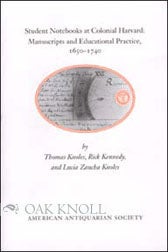Worcester: American Antiquarian Society, 2003. 8vo. stiff paper wrappers. 228 pages. Four studies relating to student manuscript production at Harvard College before 1740 that first appeared in the Proceedings of the American Antiquarian Society (Volume 109) are printed here. '" In Usum Pupillorum": Student-Transcribed Texts at Harvard College Before 1740' by Thomas Knoles and Lucia Zaucha Knoles describes a Harvard education during the college's first hundred years, when many of the texts used in instruction..... READ MORE
Price:
$20.00
other currencies
Order nr. 73131
'In Usum Pupillorum'
Student- Transcribed Texts at
Harvard College Before 1740
THOMAS KNOLES and LUCIA ZAUCHA KNOLES
ON FEBRUARY 23, 1718/19, Robert Hale, a seventeen- year-old sophomore at Harvard College, sat down with a thick blank book and began to make a handwritten copy of a manuscript treatise on arithmetic that was part of his studies at college. He worked on his copy, which eventually totaled 220 pages, on and off for the better part of a year, writing at its conclusion on November 5 that what he had written averaged 'a page a day Excluding Sabbath Days' (fig. 1). Hale continued to copy other texts into this volume during his college years, eventually transcribing seven other works on geometry, logic, metaphysics, natural philosophy, and geography. By the time Hale was finished, more than five hundred pages of his book were filled. In his freshman year he had begun to copy another particularly long and complex text with diagrams, Charles Morton's Compendium Physicae, into a separate volume of 120 pages, although ultimately he abandoned the effort. Some of Hale's transcriptions in the longer book, including the arithmetic treatise, are now the only copies known to exist. Others, such as the Morton work and a copy of Harvard tutor William Brattle's Latin text entitled Compendium Logicae, survive in multiple copies made by other students.
Hale's two volumes constitute one of the largest surviving collections of texts transcribed by a single student. However, his case is not unique, for Harvard students regularly made such transcriptions. The college opened its doors in 1638, a few months before printing began in North America. The slow progress of printing did not immediately change the college's method of teaching or its heavy reliance on student transcription. Samuel Eliot Morison wrote that 'we may be fairly certain that almost every Harvard student brought from school to college a Bible, a Latin lexicon, an edition of Cicero, and the Colloquies of Eras- mus,' but beyond this, there was no expectation that any student would possess a printed copy of anything else. Hundreds, and later thousands, of books were in the college library or owned by tutors or students, and at least some of these can be regarded as 'textbooks' in the sense that tutors read them to their students or they were used in other direct ways in the educational process. Nonetheless, for almost the first hundred years of Harvard's existence, many of the texts used in instruction in the college were manuscripts, transmitted in manuscript only. This continued to be the case until 1735, when two of the texts that had been frequently transcribed, Judah Monis's Hebrew Grammar and Brattle's Compendium Logicae, were published. From this point, the mechanics of textbook distribution at Harvard changed profoundly and permanently. A 1739 transcription of Isaac Green- wood's Algebra is the latest located copy of any manuscript text in use at the college before 1735. By then, the regular practice of student transcription had died out, although Harvard students certainly made some copies of texts after this date.
The checklist that follows represents the first attempt to com- pile a comprehensive list of manuscript texts transcribed by Harvard students during the first century of the college's existence. We have identified seventy-five volumes that Harvard students created between 1650 and 1739. Many volumes contain more than one transcribed text and in all more than fifty distinct texts may be identified. One of the volumes is in private hands; the others are held by thirteen repositories. We have found published references to at least eight volumes that cannot now be located, as well as two British copies of works of Charles Morton that have found their way to American libraries. This genre includes some relatively well-known works. For example, Morton's Compendium Physicae was probably in continual use at Harvard for nearly forty- five years and is relatively common in transcribed copies.6 Other texts have survived in a single copy without evidence either about the author or the transcriber. What all of them have in common is that they are not commonplace-book extracts, or lecture notes, or student compositions, but copies of established texts, often compiled by tutors.

